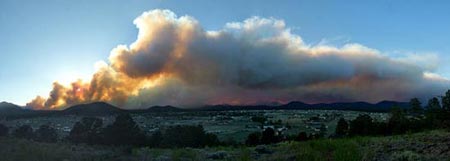Forest experts have warned for years that millions of small-diameter trees are a threat to the nation’s forests, and the massive Wallow Fire in eastern Arizona is further evidence.
With upwards of 400,000 acres engulfed in flames and zero percent containment, the Wallow Fire is now the second largest fire in Arizona history behind the massive Rodeo-Chediski Fire in 2002.
“Decades of scientific research reveal that the West is suffocating under too many trees,” said Wally Covington, Regents professor of forest ecology at Northern Arizona University and executive director of NAU’s Ecological Restoration Institute. “Where we once had 10 to 25 trees per acre, we now have hundreds.”
As a result of this unnatural forest structure, the forest cannot self-regulate, and the heavy fuel load from too many trees is setting the stage for catastrophic wildfire, he explained.
In the overly dense ponderosa pine forests, where fire once burned naturally along the forest floor every two to 10 years—killing excess tree seedlings, recycling nutrients and removing the dead and dying debris—it is now burning through the treetops.
“If we have disturbances such as wildfires, massive bark beetle infestations and disease outbreaks that are on the scale of hundreds of thousands of acres, then we have to restore landscapes on the scale of hundreds of thousands of acres. That’s exactly where we’re headed with the Four Forest Restoration Initiative and eight other landscape-scale restoration efforts across the West.”
Covington said about 180 million acres of ponderosa pine across the West are at risk and more than 300 million acres with the addition of degraded mixed conifer forests.
“Especially with drought and climate change, there is an urgent need to restore forests to their most resilient condition,” he said. “That requires protecting the old growth trees and thinning most of the small diameter trees.”
Covington said collaborative efforts such as the Four Forest Initiative that aim to accelerate large forest restoration efforts will make the difference between forests that have become liabilities and put neighboring structures at risk and forests that are assets.
“Our success in restoring forest health during the next two decades will determine whether we can leave landscape legacies for future generations.”



